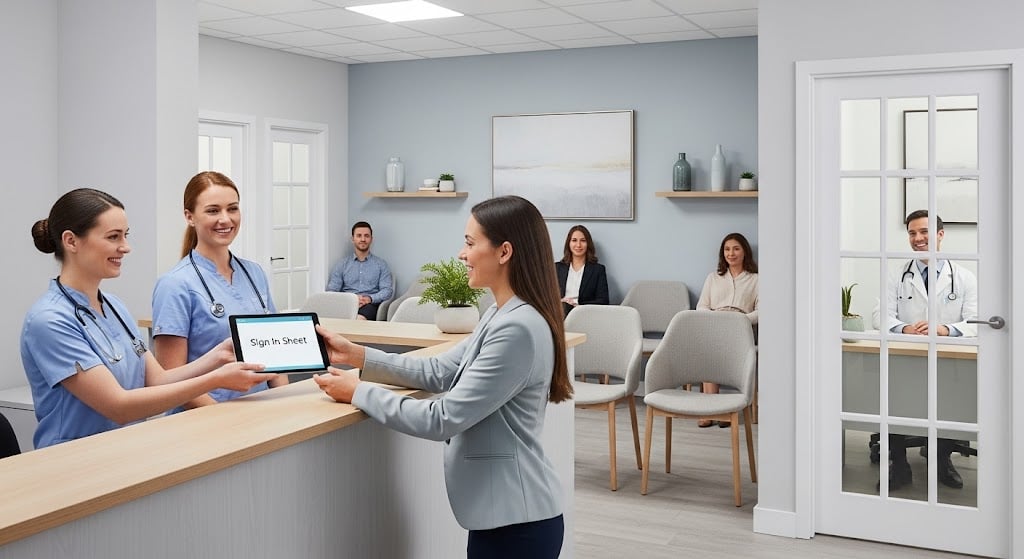What Is Clinic Workflow Management (and Why It Matters in Healthcare)
💡Clinic workflow management is the system that keeps a medical practice running smoothly. It covers every step—from patient intake to scheduling,...
6 min read
Gregory Vic Dela Cruz : Updated on September 9, 2025
.png)
Modern clinics face a huge challenge: patient demand keeps growing, but budgets do not. Hiring more people is often not an option due to rising labor costs and staffing shortages. Administrators are left asking how to improve clinic efficiency without increasing headcount.
The answer lies in smarter workflows, not more people. Manual processes like paper intake, constant phone calls, and disconnected systems drain productivity. Staff spend hours on repetitive tasks and patients grow frustrated with long waits. Healthcare providers also face empty appointment slots from no-shows. This inefficiency hurts everyone: patients, staff, and the clinic’s bottom line.
But there is another path. This is through applying clinic productivity strategies and healthcare cost-saving strategies. Clinics can reduce admin burden in healthcare and improve patient flow without hiring. In this blog, we'll discuss the inefficiencies most clinics face, their impact, and proven strategies. Keep reading to learn how you can fix them using modern, HIPAA-compliant solutions.
Inefficiency in medical offices comes with a high price tag. Missed appointments mean lost revenue. Staff overtime from handling endless phone calls increases costs. Paper-based processes create billing delays that slow down reimbursements. Industry estimates suggest inefficiencies cost U.S. healthcare systems billions annually, with small clinics losing thousands each year simply due to no-shows and wasted staff hours.
Patients feel inefficiency in the form of longer wait times, unclear instructions, and frustrating phone queues. If it takes weeks to get an appointment and hours to check in, patient satisfaction plummets. In an era where healthcare choices are abundant, dissatisfied patients often switch providers, reducing patient loyalty and hurting clinic growth.
Inefficient systems burn out staff quickly. Constant phone calls, paper processing, and retyping data into EMRs leave little time for patient-facing care. Overworked employees are more likely to resign, creating turnover costs and disrupting patient service. Healthcare staff efficiency drops when employees are stuck in administrative loops instead of providing meaningful support to patients and providers.
In short, inefficiency isn’t just an operational inconvenience—it’s a financial, patient care, and workforce crisis that threatens the sustainability of clinics.
Paper-based intake is one of the most visible bottlenecks in clinics. Patients fill out forms in waiting rooms, staff retype information into EMRs, and errors creep in. This wastes time for everyone and creates billing delays. Digital intake forms can cut check-in times by half while eliminating duplicate data entry.
Many clinics rely heavily on phone calls to handle appointment requests, confirmations, and patient questions. This leads to long hold times for patients and staff exhaustion. Studies show that secure two-way texting can reduce call volumes by up to 40%, freeing staff for higher-value tasks.
No-shows and last-minute cancellations create unpredictable schedules and wasted provider time. Manual reminder calls are inconsistent and often ineffective. Automated reminders linked to the EMR ensure patients receive timely updates and can confirm or reschedule with ease, reducing missed appointments dramatically.
From consents to billing forms, paper documentation creates inefficiencies at every stage of care. Files get lost, signatures are missed, and staff spend hours scanning and filing. Moving to secure digital forms not only speeds up processes but also ensures compliance with HIPAA and payer requirements.
These inefficiencies add up, creating barriers to patient care and draining staff morale. Fortunately, proven solutions exist to help clinics improve patient flow without hiring more staff.
No-shows are one of the biggest drains on clinic revenue. Automated appointment reminders tied directly to the EMR solve this by sending accurate, timely messages through SMS, email, or phone. Patients can confirm or reschedule with a single tap, and responses update automatically in the schedule. Clinics adopting these systems report up to a 75% reduction in missed appointments, boosting revenue and reducing provider downtime.
Paper intake forms frustrate patients and overwhelm staff. Digital intake forms allow patients to complete registration, upload insurance cards, and sign consents before arriving at the clinic. Data flows directly into the EMR, reducing check-in times by 50% and minimizing errors caused by manual re-entry. Patients also appreciate the convenience of completing forms at home.
Phone-based communication is outdated and inefficient. HIPAA-compliant text messaging allows clinics to answer patient questions, send updates, and provide instructions securely. Patients prefer texting—90% of text messages are read within three minutes. Clinics using two-way texting reduce call volumes by 40–50%, allowing staff to focus on in-person patient needs.
Telehealth visits allow clinics to provide care without using physical exam rooms. Simple follow-ups, medication refills, and chronic disease management can shift to telehealth, freeing in-office capacity for more complex cases. This improves patient flow and reduces congestion in waiting rooms. Telehealth is also a cost-saving strategy, reducing no-shows since virtual visits are easier for patients to attend.
Staff efficiency healthcare gains aren’t just about patient communication—internal communication matters too. Many clinics still rely on sticky notes, phone calls, or hallway conversations to share updates. Secure messaging platforms centralize staff communication, reducing miscommunication and delays. Integrated systems ensure tasks are documented, tracked, and completed without endless follow-ups.
Together, these strategies demonstrate how to make clinics more efficient without adding staff. By combining automation, digital tools, and secure communication, clinics can improve patient flow, reduce administrative burden, and strengthen financial stability.

A multi-specialty clinic introduced digital intake forms and saw immediate results. New patients completed paperwork at home, while returning patients updated only what changed. Check-in times dropped by half, staff re-entry disappeared, and billing accuracy improved. Patients praised the smoother process.
A family medicine practice adopted HIPAA-compliant text messaging for appointment confirmations and quick questions. Within a month, phone calls dropped by 40%. Staff had more time for in-person care, while patients received faster responses. Satisfaction scores rose significantly, and staff morale improved.
An imaging center integrated automated reminders tied to the EMR. Patients received customized reminders with prep instructions. No-show rates dropped from 20% to under 8%. The clinic recovered thousands in revenue, and providers’ schedules became more predictable.
For eCW users, integrating automated reminders ensures schedules stay accurate. Patients can confirm, cancel, or reschedule instantly, and updates appear in real time within eCW. This improves patient flow and reduces scheduling chaos.
Digital forms and HIPAA-compliant texting sync directly with eCW. Intake data flows into the chart, and patient conversations are logged automatically. This eliminates paper-based inefficiencies and ensures compliance during audits.
Curogram adds a communication and automation layer to eCW, making workflows more efficient without requiring a system overhaul. Clinics using Curogram see fewer no-shows, lower call volumes, and faster check-ins—efficiency gains that directly support staff and patient satisfaction.
Efficiency challenges in clinics are real. However, the solution isn’t always hiring more staff. By rethinking workflows and adopting modern tools, practices can greatly improve clinic efficiency. They can reduce admin burden and improve patient flow without hiring. Strategies like digital intake forms, automated reminders, secure texting, and telehealth get results. They boil down to fewer no-shows, shorter check-in times, and happier patients.
For eCW users, the path is even smoother. By integrating with platforms like Curogram, clinics can unlock efficiency with little disruption. Tools like HIPAA-compliant messaging and digital forms increase clinic efficiency without adding headcount. Healthcare cost-saving strategies not only protect margins. They also create sustainable workflows that benefit staff and patients alike.
Want to see how to make clinics more efficient in practice? Get a free demo with Curogram today.
Telehealth frees up exam rooms, makes visits more convenient, and lowers in-clinic congestion.
.png)
💡Clinic workflow management is the system that keeps a medical practice running smoothly. It covers every step—from patient intake to scheduling,...

💡What causes administrative burnout in healthcare? Disconnected systems that force staff into manual work and endless phone calls are seen as the...

💡What are workflow bottlenecks in clinics?In disconnected systems, small handoff failures pile up and become huge delays. Manual re-entry, phone...